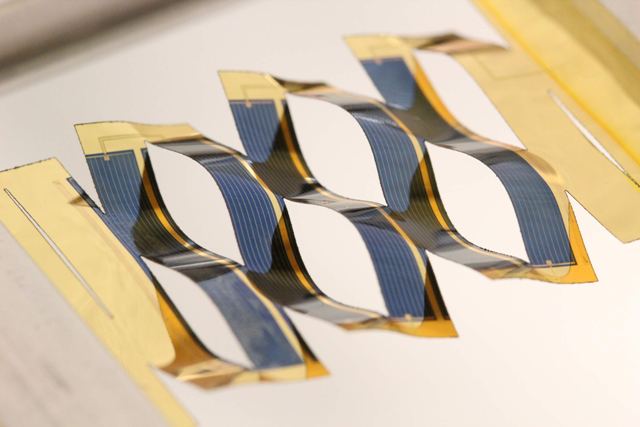Kirigami - a Japanese paper cutting art - has inspired researchers from the University of Michigan to develop solar cells that can track the sun, trapping as much as 36% more energy than stationary cells.
 By borrowing from kirigami, the ancient Japanese art of paper cutting, researchers at the University of Michigan have developed solar cells that can track the sun. A flat plastic sheet backing the solar cells splits into wavy, connected ribbons when stretched. The tilt of the cells depends on the stretching, a simple mechanism for tracking the sun across the sky. Image credit: Aaron Lamoureux
By borrowing from kirigami, the ancient Japanese art of paper cutting, researchers at the University of Michigan have developed solar cells that can track the sun. A flat plastic sheet backing the solar cells splits into wavy, connected ribbons when stretched. The tilt of the cells depends on the stretching, a simple mechanism for tracking the sun across the sky. Image credit: Aaron Lamoureux
"The design takes what a large tracking solar panel does and condenses it into something that is essentially flat," said Aaron Lamoureux, a doctoral student in materials science and engineering. Lamoureux is also the first author of the paper published under the title 'Dynamic kirigami structures for integrated solar tracking' in Nature Communications.
The Department of Energy reports that the majority of solar panel installations (almost 85%) in the U.S are on residential rooftops. However, these roofs would need heavy reinforcements were they to support the weight of traditional sun-tracking systems. An artist and a team of engineers have together fabricated an array of tiny solar cells capable of tilting within a bigger panel to maintain a ninety degree angle to the sun's rays.
Kirigami for sun-tracking solar cells | Michigan Engineering LabLog
"The beauty of our design is, from the standpoint of the person who's putting this panel up, nothing would really change," said Max Shtein. "But inside, it would be doing something remarkable on a tiny scale: the solar cell would split into tiny segments that would follow the position of the sun in unison."
Sun tracking is measured by the portion of the solar panel that is visible to the sun. A solar panel that is tilted at an angle may seem smaller. A solar array design that tilts and separates when sun rays are incident at lower angles would increase the effective area that is exposed to sunlight.
Paper artist Matthew Shlian, a lecturer at the U-M School of Art and Design, shared his expertise in paper patterns with the team of engineers. He demonstrated to Shtein and Lamoureux the technique of creating patterns on paper with the help of a plotter cutter. Then Lamoureux used a carbon-dioxide laser to create more precise designs in a space-grade plastic called Kapton.
The team experimented with many complex designs, but finally zeroed in on the simplest pattern made of a basic plastic mesh with cuts resembled a row of dashes. The Kapton strips are interconnected, and tilt proportionally with the stretch of the mesh, with an accuracy of around 1o.
The custom solar cells for the solar array were developed in the lab of Stephen Forrest, the Peter A. Franken Distinguished University Professor of Engineering and Paul G. Goebel Professor of Engineering. He, along with Lamoureux, attached these cells to an uncut Kapton piece, allowing spaces for the cuts. After this, the Kapton was cut into the required pattern with a laser cutter.
It was impossible to produce the most promising design for solar arrays with high solar-tracking ability at U-M as the cells would need to be extremely narrow and long solar cells. Increasing the width resulted in extremely long cells that didn’t fit into chambers used to develop the prototypes, so the team is investigating alternatives.
The new stretchable design is so effective thanks to how stretchable it is, allowing a large tilt angle without causing a significant decrease in width. The results of the simulations carried out during the summer solstice at Arizona showed that the new solar panel was almost on par with a conventional single-axis tracker. It also produced 36% more power compared to a stationary panel.
Under similar conditions, traditional trackers generate as much as 40% more energy than stationary panels; however, Schtein commented that these traditional designs are much heavier and bulkier, and tend to catch the wind.
"We think it has significant potential, and we're actively pursuing realistic applications," he said. "It could ultimately reduce the cost of solar electricity."
NanoFlex Power Corporation and the National Science Foundation funded the study. The university is trying to acquire patent protection for intellectual property, and is looking out for commercialization partners who can help bring the technology to the market. Forrest is a professor of computer science, material science and engineering, physics and electrical engineering, and Shtein is an associate professor of macromolecular science and engineering, art and design and chemical engineering.